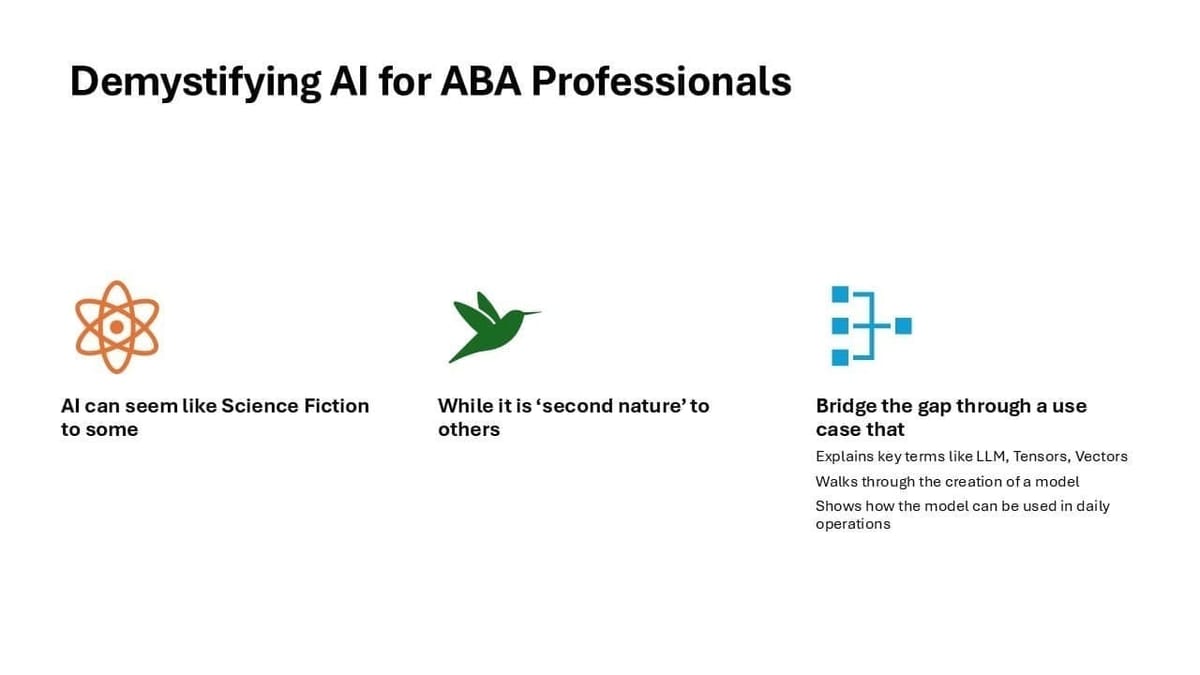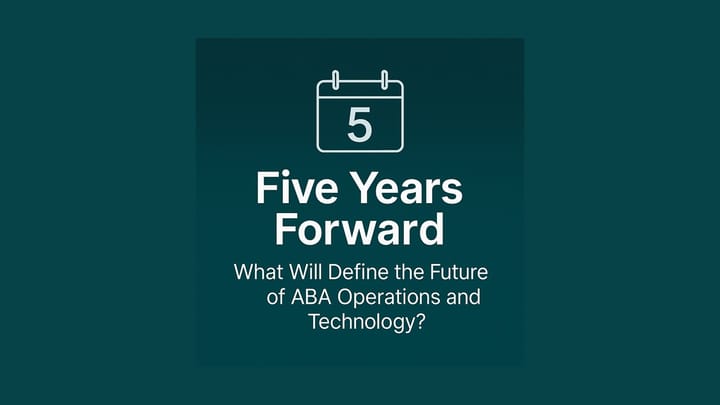🧠 Bridging the AI Gap in ABA: How It Actually Works (No Code, No Hype)

There’s a growing divide between what AI can do—and what a lot of ABA providers understand about it.
Words like LLMs, tensors, or transformers sound like science fiction to many clinicians. But at the core, it’s simpler than it seems:
You load your existing documentation into an AI system, and it helps you find patterns, summarize progress, and make smarter clinical or operational decisions.
Let’s walk through how that actually works in practice—without needing to write a single line of code.
📦 Step 1: You Load Your ABA Data Into the Model
Start by gathering the documentation you already have:
- Session notes (PDFs, EHR exports, Word docs)
- Therapist observations
- Caregiver communications
- Progress charts or behavior logs
You then upload this information into a platform or interface powered by an AI model (often a large language model, or LLM). This might mean:
- Dropping files into a secure folder
- Using a built-in tool in your existing EHR
- Connecting your data through an integration
You’re not programming anything—you’re just giving the model material to work with.
📖 Step 2: The Model “Reads” Everything
This is where the AI gets to work.
- Breaks text into “tokens” — these are chunks of language like words or phrases.
- Example: “joint attention,” “Therapist A,” “after lunch,” etc.
- Turns each token into numbers — not random numbers, but ones that represent the meaning of each word based on how it's used in context.
- So “agitation” is close to “frustration” but far from “banana.”
- Builds a structured understanding — like a smart spreadsheet that tracks:
- What happened
- Who was involved
- When and where it occurred
- How it connects to other sessions
This structured data (called a tensor) lets the model hold multiple dimensions of context at once: time, setting, behavior, therapist, intervention.
🧠 Step 3: It Finds Patterns Across Time and Context
The model uses built-in mechanisms to figure out which words or events matter most. It:
- Compares sessions over time
- Weighs therapist pairings, settings, times of day, and strategies
- Identifies which combinations lead to progress—or problems
For example:
- It may notice that agitation tends to spike after lunch in group settings
- Or that joint attention prompts with Therapist A are linked to more skill acquisition
- Or that aggression decreases when visual schedules and pre-teaching are used
This is what’s called pattern recognition—and it’s the heart of how LLMs add value.
✅ Step 4: It Gives You Useful Output
Once the AI has read and structured your data and found patterns, you can ask it questions like:
- “What strategies have been most effective for this client?”
- “What therapist or setting factors seem to impact outcomes?”
- “What should we adjust in the treatment plan?”
And it might respond:
“Aggression decreased in sessions that used pre-teaching and visual schedules, especially when Therapist A was present in the morning. Recommend increasing those strategies in afternoon sessions where agitation has been noted.”
This isn’t a generic answer. It’s based on the actual documentation you loaded—contextualized and summarized by the model.
📌 Real-World Example (Clarifying: Training Still Involves You)
Let’s make one thing clear:
You are not building the AI model from scratch.
But you do help shape it for your clinic’s use—alongside technical support.
Here’s how it works:
🧱 Step 1: The Base Model Is Pre-Trained
Before it ever sees your data, the AI has already been trained by researchers on:
- Millions of documents
- Clinical language
- Common therapy workflows
- Behavioral and operational terminology
So it already understands what “joint attention,” “manding,” or “agitation” means in general.
🛠 Step 2: You and a Technician Customize It
This is where your clinical input matters most.
You collaborate with a technician, vendor, or data analyst to:
- Provide real examples of your notes, reports, or goals
- Identify what “success” or “risk” looks like in your context
- Walk through what kinds of questions or output would be most useful
- Optionally tag or label a few sample notes (this is lightweight training)
You’re not doing data science. You’re bringing clinical judgment. The tech support team handles the mechanics—formatting the data, linking to systems, setting up queries.
⚙️ Step 3: You Use the Model in Daily Workflow
Once calibrated, the model becomes your clinical copilot.
You can:
- Upload a new batch of session notes
Ask:
“What interventions worked best this month?”
“Summarize this client’s progress toward their tacting goal.”
“Which sessions show signs of regression?”
The AI gives you structured answers—drawn from your data, shaped by your rules.
You’re not re-training the model—you’re using it.
🔁 Optional: Revisit or Fine-Tune as Needed
If your documentation format changes, or you want to focus on a different clinical domain (e.g., social goals instead of behavior reduction), you can fine-tune again.
That might involve:
- Feeding in new examples
- Adjusting priorities
- Expanding your prompts
Think of it like tuning a guitar—not rebuilding the instrument.
✅ Summary: Who Does What
| Step | Who’s Involved | What Happens |
|---|---|---|
| Pre-training | AI developers | Model learns general clinical language and logic |
| Customization | Clinician + tech support | You guide the model using real clinic examples |
| Day-to-day use | Clinician | You run the model to analyze your data and get insights |
| Refinement | Optional | You update the setup as your needs evolve |
👁️ Bonus: You Can See Why the AI Said That
Some platforms include explainability tools that show:
- Which words or notes the model focused on
- What evidence contributed to the recommendation
- How confident the model was in its output
This builds trust—you don’t just get an answer; you see why the model suggested it.
🚀 Why This Matters for ABA Providers
AI in ABA isn’t about replacing clinical teams. It’s about:
- Summarizing large volumes of information quickly
- Highlighting what’s working and why
- Reducing rework or documentation gaps
- Helping BCBAs and directors focus on higher-level decision-making
And once it’s aligned to your workflows, it scales with you—making your data more actionable without adding more admin overhead.



